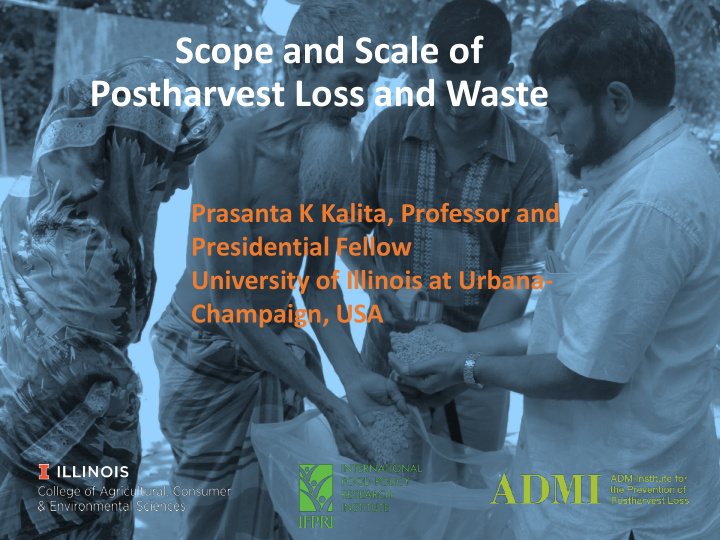



Scope and Scale of Postharvest Loss and Waste Prasanta K Kalita, Professor and Presidential Fellow University of Illinois at Urbana- Champaign, USA
Food Insecurity and Hunger United Nations (2017) Most of the population increase in developing countries At present 840 M 0 Million on suffering from hunger Photo Source: http://www.prb.org/publications/datasheets/2013/2013-world-population-data-sheet/world-map.aspx#map/world/population/2013
How to Increase Food Availability? Increase land area under agricultural production Improve agricultural efficiency Use high yielding crop varieties or GMO Crops Challenges Limited land and water resources Rapid Urbanization Use of land to produce non-food crops Climate Change
Postharvest Loss and Waste Globally one third of the food is lost or wasted every year = 1.3 billion tons per year 1.3 billion tons > Can feed 37 million people for lifetime Type of Losses Weight loss Quality Deterioration Nutritional Loss Seed viability loss Aspergillus 's mold on rice seed 198 million h ectares is used to produce food that is lost or wasted each year. (About the area of Mexico) Source: Lipinski et al 2013. Reducing Food Loss and Waste. World Resource Institute
Impact of Postharvest Loss & Waste Reduce food Waste of resources and availability and food Less Income -> Poor produce emissions -> quality -> Food Livelihood Burden the ecosystem Insecurity $ 4 Billion 1 in 9 3.3 Gtonnes Annual Grain loss in People Don’t have CO 2 Emissions due to sub-Saharan Africa (SSA) Sufficient Food Food Loss/waste may be easier to prevent food loss than to produCe more food
Posth tharvest L st Losse ses s in C Cereals Food Security Issue: Based on caloric content, cereals comprise the largest share of global food loss and waste ―53 %
Posth tharvest L st Losse ses s in R Rice: Internat ational V Variation on Most of these losses occur during storage.
Posth tharvest L st Losse ses s in R Rice: I Intra-Nat ational al Variati tion a and P Process ss Variati tion Estimated postharvest loss of rice in India Maximum losses were observed during harvesting and storage stages Data Source: Kannan et al (2014) Assessment of Pre and Postharvest Losses of Important Crops in India
Postharvest L Losse ses s in Blac ack G Gram am: Variations B Between S States i in India 30% 25.28% 25% 22.68% grading & repacking 20% storage threshing 15% drying 10% harvesting 5% 0% Maharashtra Madhya Pradesh 9
Be Between th the f farm and th the t table lies th the r rot a t and a racket As of January 1, 2019 4,135.224 tonnes of ‘damaged’ grain in FCI godowns in India Bihar accounts for 3,567.65 tonnes (86%) Punjab, with about 324.39 tonnes and a history of storage issues, comes second among the states.
Posth tharvest L st Losse ses: s: B Bangladesh sh Grain Losses in Food Supply Chain in Bangladesh Storage and drying critical stages Data Source: Bala et al (2010) Post Harvest Loss and Technical Efficiency of Rice, Wheat and Maize Production System: Assessment and Measures for Strengthening Food Security
Factors a and C Cause ses o of L Losses Ref: Kalita and Kumar (2015) eFOOD-Lab_International, 4: 24-26
Global Postharvest Loss Status Highly Less developed developed Wastes Losses
Reta tail a and C Consumer F Food L Loss a and W Wast ste (FLW) i in the U USA SA
Economic v value of FLW i W in n the e USA SA Total = $161.6 billion Retail FLW = $46.7 billion Consumer level FLW = 114.9 billion Energy E Embe bedde dded i d in FLW i in the USA SA Total Energy = 2.1x10 18 joules • It is equivalent to energy loss of 25% of total energy consumption in the entire farm-to-fork food system • It is equivalent of 2% of all-purpose energy use in the entire country
To put into perspective.. (CAST Issue Paper No. 62, September 2018)
Recommend
More recommend